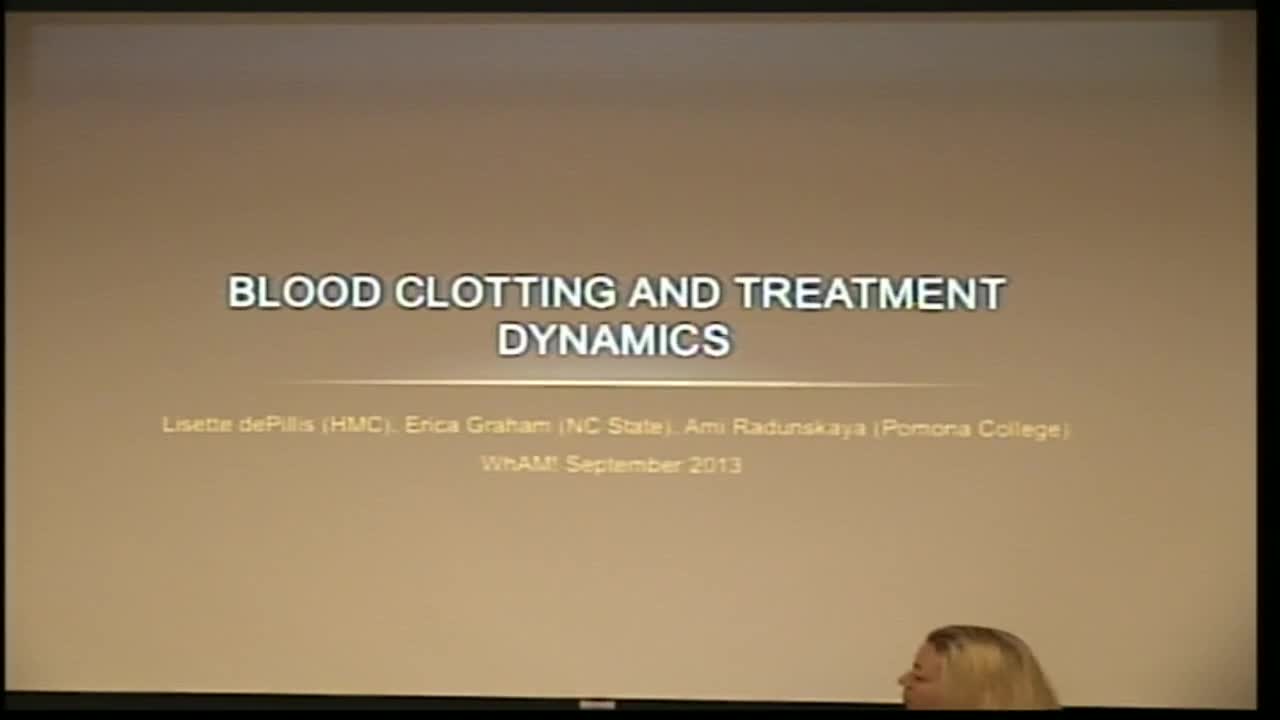Modeling Anti‐coagulation Therapy
Presenters
September 9, 2013
Abstract
The Questions
Anti-coagulation therapy is often prescribed after surgery in order to prevent
the formation of dangerous clots that could cause strokes or respiratory obstructions. However, the clotting properties of blood are naturally tightly regulated by the healthy body, and these treatments can upset these innate regulatory processes. Furthermore, anti-coagulants have negative side effects such as excessive bleeding. For example, people taking anti-coagulants can experience dangerous clotting after airplane flights, despite a lack of clinical evidence that flying adversely affects clotting activity. In this project, we hope to build mathematical models to address several key questions about the administration of these anti-coagulant drugs. Some of these questions are:
What should the dosing be: how much drug should be given, and how
often?
How do current monitoring practices reflect actual anti-coagulation activity (for example, how good of a proxy is the INR)?
How do we model pressure changes that reflect airplane flight (ground
level air pressure versus the pressure in an airplane that is flying at 30,000
feet)?
How would blood vessel damage affect clotting? Can scar tissue in the
blood vessels or damage to the vascular pumps have a significant effect?
Possible Approaches
Currently, mathematical models of blood clotting exist. As a starting point, we
propose to add a PK-PD model of a common anti-cogulant, such as Warfarin or Coumadin, to exiting models of blood clotting, such as the spatial model of
Fogelson-Leiderman, [2].
Choose a common anticoagulation therapy (such as Warfarin or Coumadin). Add the associated PK/PD representing Coumadin action to the Fogelson-Leiderman spatial blood clot formation model. Heuristic optimization procedures could be used to answer the doing question. Simulations could illuminate the relationship between commonly used proxies for anit-coagulation activity and what is actually happening. Finally, model parameters can be adjusted to represent changes in the host’s environment, such as the change in pressure experienced during an airplane flight, or the changes in tissue properties that follow major surgery or trauma.
References
[1] A. J. M. dePont, J. H. Hofstra, D. R. Pik., J. C. M. Meijers and M. J. Schultz. Pharmacokinetics and pharmacodynamics of danaparoid during continuous venovenous hemofiltration: a pilot study. Critical Care 11:R102 (2007). (doi:10.1186/cc6119)
[2] K. Leiderman and A. Fogelson. Grow with the flow: a spatialtemporal model of platelet deposition and blood coagulation under flow. Mathematical Medicine and Biology 28: 47?84 (2011) (doi:10.1093/imammb/dqq005).
[3] E. Pasterkamp, C. J. Kruithof, F. J. M. Van der Meer, F. R. Rosendaal and J. P. M. Vanderschoot. A model-based algorithm for the monitoring of long-term anticoagulation therapy. Journal of Thrombosis and Haemostasis, 3:915921 (2005).
[4] S. Thijssen, A. Kruse, J. Raimann, V. Bhalan, N. W. Levin and P. Kotanko
. A Mathematical Model of Regional Citrate Anticoagulation in Hemodial-
ysis. Blood Purif. 29:197203 (2009). (doi: 10.1159/000245647)
[5] R. Vink, R. A. Kraaijenhagen, M. Lei and H. R. Büller. Individualized
duration of oral anticoagulant therapy for deep vein thrombosis based on a decision model. Journal of Thrombosis and Haemostasis, 1: 2423–2530 (2003)
[6] F. F. Weller. A free boundary problem modeling thrombus growth. Model
development and numerical simulation using the level set method. J. Math.
Biol., 61: 805–818 (2010) (doi:10.1007/s00285-009-0324-1).
Project Leaders
Ami Radunskaya, (Pomona College, Claremont CA 91711)
Lisette de Pillis (Harvey Mudd College, Claremont CA 91711)
Erica Graham (North Carolina State, Raleigh NC )
